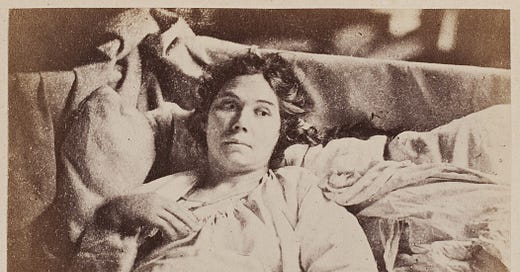In the past, how did women rebuild themselves after trauma?
Case study: female inpatients at La Salpêtrière hospital in the 1880s
Hi everyone,
First, I MUST share with you some pics of our new kittens. Back in November, a friend found a litter of kittens dumped by a river. She asked if I wanted to take a couple. I umm-ed and ahh-ed over it for a few hours, and thought it would be lovely for my girls to be around kittens growing up, and said ‘yes’. But when my friend took them to a vet, it became apparent that the kittens were just around a week old and needed bottle-feeding every two hours, day and night, so they went to be cared for in a cat rescue. I followed the rescue on Facebook, more to watch the kittens’ progress rather than with any more thoughts of taking them on myself. They grew, and flourished, and had their first and then second course of vaccinations, and were put up for adoption. And then, a fortnight ago, the rescuer posted that she was having trouble finding a home for two sisters from the litter, who needed to be adopted together, and would do best in a home with lots of children and other animals. ‘Oh, go on then,’ I thought, and got in touch with her. Yesterday I brought the kittens - Cleo and Daisy - home. It was the third anniversary of my husband’s death, so a bleak bleak day, but I hope that the arrival of these curious, playful, snuggly bundles of fluff will brighten the coming weeks and months for me and my girls.


This week’s newsletter is very much a report from work-in-progress. By that, I mean that I don’t yet have a crafted conclusion to draw from this reading, but I find it all fascinating and wanted to share it with you nonetheless. And if you have anything to add in the comments, I’d be very grateful! It’s always lovely to hear from these newsletters’ readers.
As you’ll have gleaned by now, I’m interested - personally and intellectually - in trauma: specifically in women’s trauma, and, more specifically, in how men traumatise women, with the effect of crushing our spirit and stifling our capacity for defending our rights and needs, both personally and politically. In times of backlash, when this occurs with particular frequency and ferocity, part of the work of feminism is to go back to basics and to support women in rebuilding ourselves, which is the necessary groundwork before collective action becomes possible. So I’m interested in the intersections between feminism and trauma studies/trauma-informed therapy and, as part of that work, I’m also interested in how the medical and psychotherapeutic establishment have treated women who have suffered trauma at the hands of men - and how women have often had to develop their own alternative means of recovery.
Recently, I’ve been thinking about traumatised women in the past. I’ve been wanting to know more about how they were treated, and whether mainstream treatments and therapies were helpful (or the opposite), and if they also found their own ways of processing their trauma. This newsletter is about one particular group of such women: the female patients in La Salpêtrière hospital in Paris in the 1880s. As I say, this is very much a work-in-progress (or, more accurately, a work-in-its-beginning-stages): I’ve only done a few days reading about these women, and am very much not an expert!



